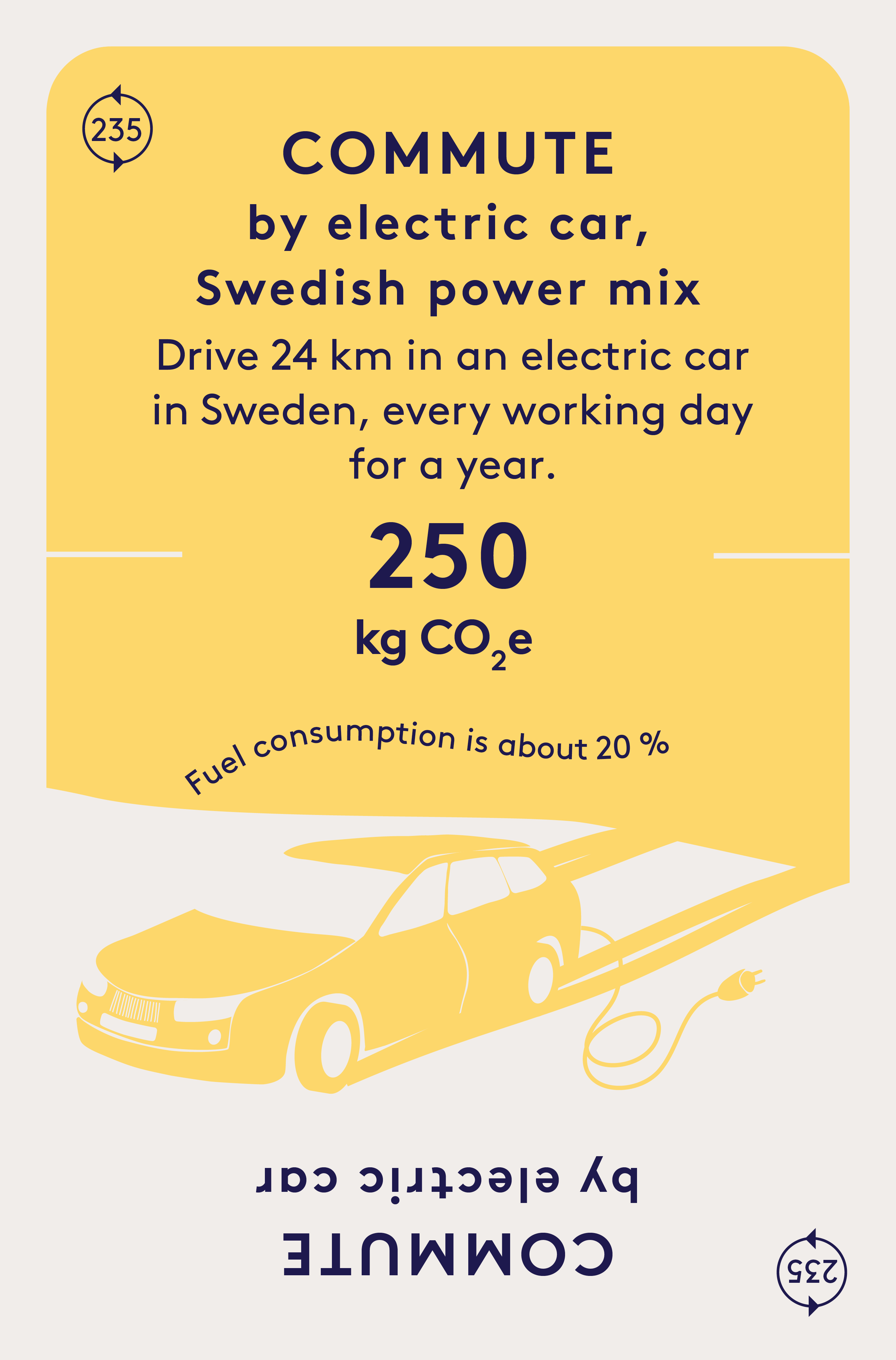COMMUTE
by electric car, Swedish power mix

FOLLOW OUR CALCULATION
Click the expendable headlines to look at each step of the calculation.
To calculate the greenhouse gas emissions, we have included the emissions from the consumption of electricity and the emissions from the production of the electric car and the battery. The following data have been used to calculate the emissions from electricity consumption:
- Commuting distance one way: 12 km every working day (this value refers to the average commuting distance for trips to/from school/work by car and/or public transport according to a Swedish Travel Survey from 2017)
- Number of working days per year: 235 (5 days per week, 47 working weeks per year)
- Electricity consumption: 0.67 MJ per km (refers to a Nissan Leaf 24 kWh according to data from UCS, 2015)
- Emissions from the average electricity mix in Sweden: 13 g CO2e per MJ (source: Swedish Energy Agency, refers to the year 2019)
We have assumed that only one person travels in the car.
The amount of electricity consumed is calculated by multiplying the electricity consumption per km by the total commuting distance. The calculation shows that electricity consumption amounts to 3 779 MJ per year (0.67 MJ per km × 24 km per day × 235 days per year).
The greenhouse gas emissions from electricity consumption are calculated by multiplying the electricity consumption by the emission factor for electricity. The calculation shows that the emissions amount to 49 kg CO2e per year (3 779 MJ × 13 g CO2e per MJ).
The emissions from the manufacture of the car are calculated based on data on the weight of the car, its lifetime, the distance traveled, the materials it is made of, and the emission factors for the different materials. The emission factors indicate how much greenhouse gas is emitted during the extraction and enrichment of 1 kg of material. The following data have been used:
– Car lifespan: 16.5 years (typical value for cars in Northern Europe)
– Average distance traveled per year: 11 500 km
– Weight of the car: 1 400 kg
– Material composition of the car (percentages of total weight excluding battery based on data from UCS, 2015; refers to a Tesla Model S): carbon steel 55%, stainless steel 13%, plastic 12%, aluminum 6%, glass 3%, copper 5%, synthetic rubber 2%, and other materials 4%.
– Emission factors for the materials that the car consists of: carbon steel 2.2 kg CO2e/kg, stainless steel 4.5 kg CO2e/kg, plastic 2.5 kg CO2e/kg, aluminum 7.3 kg CO2e/kg, glass 0.9 kg CO2e/kg, copper 5.8 kg CO2e/kg, and synthetic rubber 1.9 kg CO2e/kg. For the other materials, we have used an average emission factor of 3.4 kg CO2e/kg.
The carbon footprint of a newly manufactured car is calculated by multiplying the weight of the constituent materials by the emission factors of the corresponding materials. The calculation shows that a newly manufactured electric car (without battery) has a carbon footprint of 4 243 kg CO2e (note that we have included more significant values in our calculation model, so this figure differs slightly from the result obtained if the calculation is made using the data given above).
Note also that the material composition of an electric car is slightly different from a car with an internal combustion engine (compare, for example, with a small diesel car). Among other things, an electric car consists of a larger proportion of copper, and a smaller proportion of carbon steel, than a car with an internal combustion engine.
A newly manufactured car battery with a capacity of 60 kWh has a carbon footprint of 2 370 kg CO2e, according to our calculation model. This means that a newly manufactured electric car with a battery has a carbon footprint of 6 613 kg CO2e (4 243 + 2 370 kg CO2e). This entire amount of emissions should not be included when calculating the emissions of the commuting trips, but only the share corresponding to the actual commuting distance.
Overall, the electric car travels 189 750 km during its lifetime (11 500 km per year × 16.5 years). The commuting distance of 5 640 km (235 days per year × 24 km per day) is therefore equivalent to 3% of the total distance traveled by the car (5 640 km/189 750 km). An equal share of the emissions for manufacturing the car and the battery is attributed to the actual distance traveled, i.e. 198 kg CO2e (6 613 kg CO2e × 3%).
The total emissions for all commuting trips are calculated by adding the emissions from electricity consumption to the emissions from the manufacturing of the car and the battery. The calculation shows that the commuting causes emissions of 247 kg CO2e per year (49 + 198 kg CO2e per year), which has been rounded to 250 kg CO2e on the card.
See more card calculations: